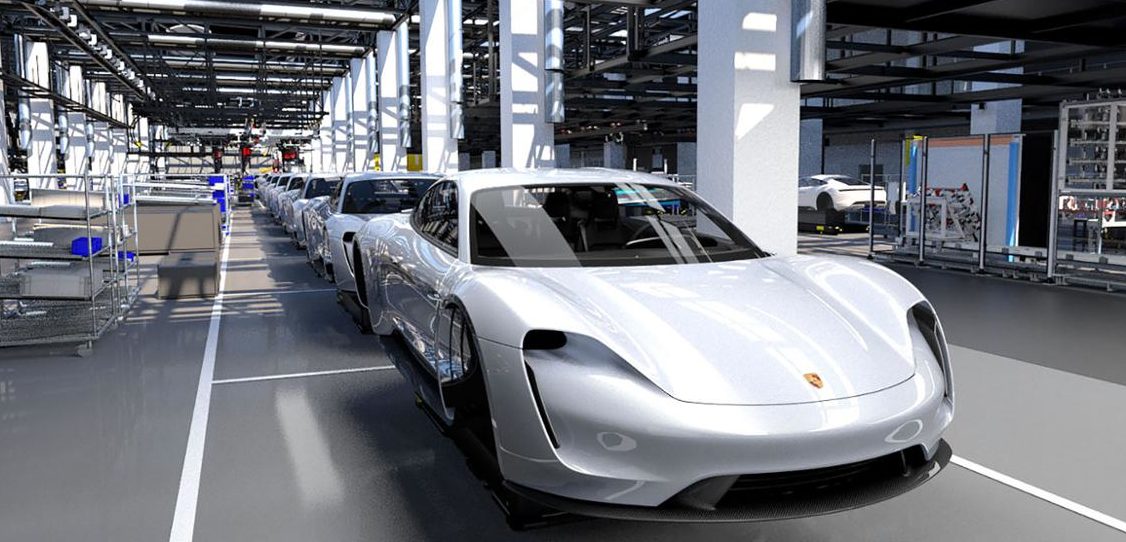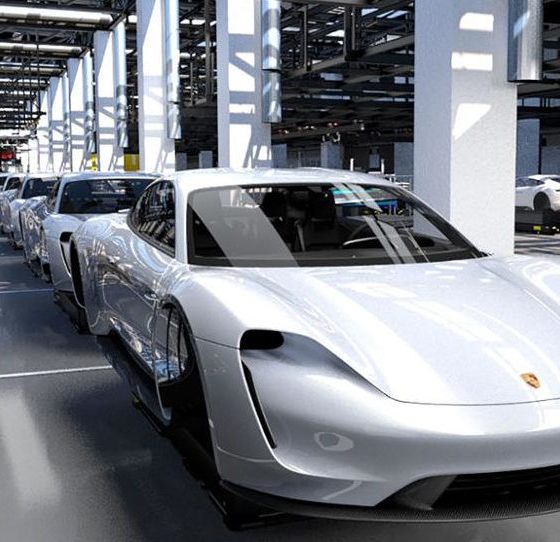

News
Porsche’s production plans for Taycan and new 911 hint at serious electrification
In a recent interview, Porsche executive board member Albrecht Reimold hinted at the plans for the upcoming production ramp of the Taycan — the company’s first all-electric car. During the interview, the Porsche executive described how the Taycan’s production is closely related to the manufacturing of the 911, and how the company is getting one of its most iconic vehicles for electrification in the future.
Only a few of Porsche’s creations can hold a candle to the legendary 911, a premium sports car whose performance borders on the supercar level. Porsche is currently preparing its new 911, and Reimold has noted that plans are underway to prepare for the vehicle’s production. Coincidentally, the new 911 would be produced side-by-side with the upcoming Taycan. The Porsche executive further stated that the production of the two cars would have some similarities, to the point that the new 911 could actually be built in the Taycan’s manufacturing lines.
“There is some overlap of course; starting with the logistics processes, and we are also building a new paint shop that all models could be painted in. We have built lots of flexibility into production so that the 911 can also be produced in the Taycan assembly plant – though not vice versa,” he said.
During the interview, the Porsche executive was asked if the strategy for the 911 and Taycan production line was set as a precaution in case the electric car fails to succeed on the market. Reimold answered the question confidently, stating that all signs are pointing to the Taycan making a significant impact in the luxury car industry. The exec added that based on his own experience with the upcoming vehicle, he is quite optimistic about the Taycan’s chances on the market.
“Based on feedback from the market, the calculation of 20,000 Porsche Taycan models in the first year may be a rather conservative estimate. I’ve had the pleasure of driving the car myself, and I can only say it’s absolutely fantastic! Which is the response we’ve been hearing from all sides,” he said.
Perhaps the most notable statement in the interview with the Porsche executive is about the future of the 911 as the company embraces electrification. Porsche is among the veteran carmakers that has dedicated itself to pushing electrified transportation, announcing last year that it was retiring its diesel-powered lineup of vehicles in favor of all-electric or hybrid cars. In the case of the new 911, Reimold explained that while there are no plans for an electrified version of the iconic vehicle, the company is ready to implement a hybridization strategy for the sports car.
“(Hybridization) is still a rather minor one because customers expect the 911 to be what it is. But it’s not entirely out of mind. For example, we have designed the model to enable drivetrain electrification – hybridization in other words, so we would be ready to implement a change like that,” he said.
Reimold also noted that the 911 would always be an icon for the company, despite the all-electric Taycan dominating Porsche’s headlines today. Overall, if there is anything invoked by Porsche’s plans for the 911 and the Taycan’s production, it is that the carmaker is not shying away from electrification. Building one of its most important and historic vehicles alongside its first-ever all-electric car, after all, shows a notable commitment towards electrification.
The Porsche Taycan is expected to start production sometime later this year. The carmaker is yet to unveil the production version of the Taycan, though sightings of the company’s test mules hint at serious track performance.

News
Tesla FSD fleet is nearing 7 billion total miles, including 2.5 billion city miles
As can be seen on Tesla’s official FSD webpage, vehicles equipped with the system have now navigated over 6.99 billion miles.

Tesla’s Full Self-Driving (Supervised) fleet is closing in on almost 7 billion total miles driven, as per data posted by the company on its official FSD webpage.
These figures hint at the massive scale of data fueling Tesla’s rapid FSD improvements, which have been quite notable as of late.
FSD mileage milestones
As can be seen on Tesla’s official FSD webpage, vehicles equipped with the system have now navigated over 6.99 billion miles. Tesla owner and avid FSD tester Whole Mars Catalog also shared a screenshot indicating that from the nearly 7 billion miles traveled by the FSD fleet, more than 2.5 billion miles were driven inside cities.
City miles are particularly valuable for complex urban scenarios like unprotected turns, pedestrian interactions, and traffic lights. This is also the difference-maker for FSD, as only complex solutions, such as Waymo’s self-driving taxis, operate similarly on inner-city streets. And even then, incidents such as the San Francisco blackouts have proven challenging for sensor-rich vehicles like Waymos.
Tesla’s data edge
Tesla has a number of advantages in the autonomous vehicle sector, one of which is the size of its fleet and the number of vehicles training FSD on real-world roads. Tesla’s nearly 7 billion FSD miles then allow the company to roll out updates that make its vehicles behave like they are being driven by experienced drivers, even if they are operating on their own.
So notable are Tesla’s improvements to FSD that NVIDIA Director of Robotics Jim Fan, after experiencing FSD v14, noted that the system is the first AI that passes what he described as a “Physical Turing Test.”
“Despite knowing exactly how robot learning works, I still find it magical watching the steering wheel turn by itself. First it feels surreal, next it becomes routine. Then, like the smartphone, taking it away actively hurts. This is how humanity gets rewired and glued to god-like technologies,” Fan wrote in a post on X.
News
Tesla starts showing how FSD will change lives in Europe
Local officials tested the system on narrow country roads and were impressed by FSD’s smooth, human-like driving, with some calling the service a game-changer for everyday life in areas that are far from urban centers.

Tesla has launched Europe’s first public shuttle service using Full Self-Driving (Supervised) in the rural Eifelkreis Bitburg-Prüm region of Germany, demonstrating how the technology can restore independence and mobility for people who struggle with limited transport options.
Local officials tested the system on narrow country roads and were impressed by FSD’s smooth, human-like driving, with some calling the service a game-changer for everyday life in areas that are far from urban centers.
Officials see real impact on rural residents
Arzfeld Mayor Johannes Kuhl and District Administrator Andreas Kruppert personally tested the Tesla shuttle service. This allowed them to see just how well FSD navigated winding lanes and rural roads confidently. Kruppert said, “Autonomous driving sounds like science fiction to many, but we simply see here that it works totally well in rural regions too.” Kuhl, for his part, also noted that FSD “feels like a very experienced driver.”
The pilot complements the area’s “Citizen Bus” program, which provides on-demand rides for elderly residents who can no longer drive themselves. Tesla Europe shared a video of a demonstration of the service, highlighting how FSD gives people their freedom back, even in places where public transport is not as prevalent.
What the Ministry for Economic Affairs and Transport says
Rhineland-Palatinate’s Minister Daniela Schmitt supported the project, praising the collaboration that made this “first of its kind in Europe” possible. As per the ministry, the rural rollout for the service shows FSD’s potential beyond major cities, and it delivers tangible benefits like grocery runs, doctor visits, and social connections for isolated residents.
“Reliable and flexible mobility is especially vital in rural areas. With the launch of a shuttle service using self-driving vehicles (FSD supervised) by Tesla in the Eifelkreis Bitburg-Prüm, an innovative pilot project is now getting underway that complements local community bus services. It is the first project of its kind in Europe.
“The result is a real gain for rural mobility: greater accessibility, more flexibility and tangible benefits for everyday life. A strong signal for innovation, cooperation and future-oriented mobility beyond urban centers,” the ministry wrote in a LinkedIn post.
News
Tesla China quietly posts Robotaxi-related job listing
Tesla China is currently seeking a Low Voltage Electrical Engineer to work on circuit board design for the company’s autonomous vehicles.

Tesla has posted a new job listing in Shanghai explicitly tied to its Robotaxi program, fueling speculation that the company is preparing to launch its dedicated autonomous ride-hailing service in China.
As noted in the listing, Tesla China is currently seeking a Low Voltage Electrical Engineer to work on circuit board design for the company’s autonomous vehicles.
Robotaxi-specific role
The listing, which was shared on social media platform X by industry watcher @tslaming, suggested that Tesla China is looking to fill the role urgently. The job listing itself specifically mentions that the person hired for the role will be working on the Low Voltage Hardware team, which would design the circuit boards that would serve as the nervous system of the Robotaxi.
Key tasks for the role, as indicated in the job listing, include collaboration with PCB layout, firmware, mechanical, program management, and validation teams, among other responsibilities. The role is based in Shanghai.
China Robotaxi launch
China represents a massive potential market for robotaxis, with its dense urban centers and supportive policies in select cities. Tesla has limited permission to roll out FSD in the country, though despite this, its vehicles have been hailed as among the best in the market when it comes to autonomous features. So far, at least, it appears that China supports Tesla’s FSD and Robotaxi rollout.
This was hinted at in November, when Tesla brought the Cybercab to the 8th China International Import Expo (CIIE) in Shanghai, marking the first time that the autonomous two-seater was brought to the Asia-Pacific region. The vehicle, despite not having a release date in China, received a significant amount of interest among the event’s attendees.








